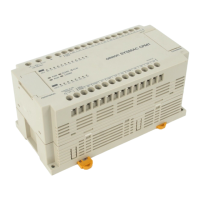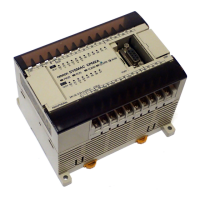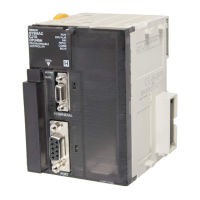(001)
END
(202)
TOUT
0000
00
A500
06(=)
ST0000
TN0000
ST0010
(020)
CMP D10000 D20000
Transition condition
TN0000
434
If the Transition Flag turns ON, ST0000 is active (but not in pause status), and
ST0010 is inactive, then all of the transition conditions are met and active status
will be transferred from ST0000 to ST0010.
Address Instruction Operands
00000 LD 000000
00001 CMP(020)
D10000
D20000
00002 AND A50006
00003 TOUT(202)
00004 END(001)
5-37-8 TRANSITION COUNTER: TCNT(123)
(123)
TCNT N S
S: No. of executions CIO, G, A, T, C, #, DM, DR, IR
N: Counter number C
Operand Data AreasLadder Symbol
Description When the execution condition is OFF, TCNT(123) is not executed. When the
execution condition is ON, TCNT(123) turns a corresponding Transition Flag
ON or OFF according to the number of times the transition program is executed.
The counter is started the first time TCNT(123) is executed with an ON execution
condition after it is reset and the present value is incremented starting with the
second execution. Therefore, the actual number of execution will be S + 1.
When the present value reaches the value set for S, the Transition Flag and the
Counter Flag will turn ON.
The status of the transition counter is maintained even when step status is
changed, so the transition counter should normally be reset using CNR(236) in
the previous step.
If either TOUT(202) and/or TCNT(123) is used more than once in one transition
program, the status of the Transition Flag will be controlled by the last
TOUT(202) or TCNT(123) in the transition program.
TCNT(123) cannot be used outside of a transition program and writing to the
Transition Flag area cannot be achieved with any instructions other than
TOUT(202) (see previous section) and TCNT(123).
Note 1. A50015 (First Cycle Flag) cannot be used within a transition program.
2. The following three conditions must be met in order for active status to be
transferred from one step to another:
The transition condition (i.e., the Transition Flag) must be ON.
The step(s) before the transition must be active (execute or halt, but not
pause).
The step(s) after the transition must be inactive.
Precautions S must be in BCD.
The same counter numbers are used by CNT, CNTR(012), and TCNT(123). Do
not use the same number to define more than one counter, regardless of the
counter instruction used.
The transition counter counts each time the transition program is executed.
When using a parallel join, be particularly careful of the number that is set, be-
cause the transition program will be executed each time the steps just above the
transition are executed.
SFC Control Instructions Section 5-37

